Email marketing customer journey: the complete guide
Time to read: 9 minutes
The email marketing customer journey is the pillar to your email program's success.
You probably have an ideal journey for customers in mind—they see your brand, love what you have to offer, make a purchase, and keep coming back for more. But the reality isn’t usually that linear.
That’s where the customer journey can help. It tracks the path your customers actually take as they interact with your business, from encountering your brand for the first time to converting and beyond.
The customer journey is a key marketing framework that uses data from all your channels to understand the customer’s experience. Mapping this journey helps you improve that experience, which extends your relationship with the customer.
Email is one of the most important marketing channels for moving prospects through each stage of the customer journey. That’s because email is one of the most direct ways to nurture customers with personalized communications linked to their actions.
This post will cover how you can use the customer journey to inform your email marketing strategy.
What is the email marketing customer journey?
Often, we think about the email customer journey as how to get a potential buyer from Point A to Point B—but it's about much more than that. Just like a roadtrip, it's all about the stops and experiences along the way. Focus too much on the end destination, and your customers will never make it.
Your email marketing customer journey is all about creating a series of email interactions that feel less like random pit stops and more like a curated adventure.
Imagine trying to travel without a map or GPS—pretty challenging, right? Without understanding the email marketing customer journey, your messages might end up like a tourist in a new city without Google Maps—lost, confused, and possibly eating at the worst-rated restaurants. The customer journey helps you send the right message, to the right person, at the right time, (with email, of course).
This journey typically unfolds in several stages:
- Awareness: Like catching a glimpse of a billboard for the world’s best coffee just off the next exit, this stage is where potential customers first hear about your brand.
- Consideration: Now they know you exist, but they're reading reviews and checking out your competitors. Your emails here need to dazzle them—like free taste tests at that coffee shop.
- Purchase: They’ve decided to take the exit and visit your shop. Purchase emails are your chance to make the buying experience as smooth as a good espresso.
- Retention: Keep them coming back with loyalty perks, new arrivals, or just a friendly hello. It’s like having their favorite coffee order ready right when they walk in.
- Advocacy: When customers love your brand so much, they can’t stop raving about it to friends. This is the stage where your emails encourage them to share their love for your brand, turning them into your personal brand ambassadors.
Why is the customer journey important?
The customer journey helps you understand customers’ behavioral patterns as they move toward a conversion and the touchpoints along the way. A touchpoint is any interaction with your brand, such as visiting your website, following your social media channels, signing up for your email list, and engaging with marketing emails.
But perhaps more importantly, mapping the customer journey helps you understand any roadblocks that deter a potential customer from taking the desired action. Once you know what’s stopping them, you can clear the way for a more positive customer experience—that hopefully leads to conversion.
Mapping the email marketing customer journey
Mapping your customers’ journey takes a lot of data across channels, as your customers typically encounter your brand on a variety of platforms.
For this post, we’ll focus on one of these channels—email—and how you can align your strategy to the customer journey map. Using email automation, you can ensure the recipient gets the right message at the right time to help them transition to the next stage.
As you map the customer journey to inform your email marketing strategy, here are some key factors to consider and questions to ask yourself.
Buying process
Start with the most readily available data—your sales, sign-ups, or whichever conversion metrics you measure. Ask yourself, how are customers purchasing your products or services? Do they go to a store or purchase from social media ads?
Understanding this process can help you tailor your marketing emails. For example, if a customer makes a purchase from an Instagram ad, you can target them with relevant email messaging, such as an influencer campaign, that’s likely to resonate. If, on the other hand, a customer typically purchases in person, send them a coupon to redeem at their preferred location.
Actions
Next, look beyond conversions and dig into the actions customers take at each touchpoint. Do they follow you on social media, peruse your products on your website, or seek online reviews?
The better you understand the user’s actions, the more relevant emails you can send. For example, if users typically search for reviews before making a purchase, you can include customer reviews in your marketing emails.
Pain points and obstacles
After discovering what actions your customers take, you’ll need to go a step further to address their pain points.
Pain points are the moments when customers experience negative emotions (e.g., anger, frustration, etc.) that derail them from the action you want them to take. Sure, emotions can be harder to infer from the customer’s actions, but emotions are also crucial to understanding the journey—especially the negative ones.
While it’s great to know when customers have a good experience with your business, it’s more important to understand where they encounter obstacles. Online reviews and customer service interactions are great places to gauge users’ emotions and find the pain points along their journey.
For example, are you getting a lot of complaints about the checkout process? Are customers saying they had a negative experience with customer service? Do orders take too long to ship? These are the types of obstacles that can cut your relationship with the customer short.
Solutions
Don’t stop at understanding customers’ pain points. Once you’ve gathered this data, work to resolve the most common issues and clearly communicate your solutions to customers.
For example, say you received a lot of complaints about the complicated checkout process on your website, so you hired a web developer to revamp your website and make the buying process more streamlined. There may be some past customers who haven’t returned to your website since their last bad experience, so let them know that you fixed the issue.
You can do this by promoting your new website in a marketing email and giving recipients an incentive to check it out, such as a discount on their next purchase.
Aligning your email marketing strategy to the customer journey
Once you have a clear understanding of how customers discover and engage with your brand, you can tailor your email communications to meet them along the different stages of the journey. Let’s look at how you can align your email marketing strategy to the customer journey.
Brand awareness
This is when the user first encounters your brand, whether they find you through a Google search, see an ad on social media, or hear about your brand elsewhere.
The brand awareness stage is an opportunity to capture a user’s email address to connect with them more directly. To do this, promote your email program on the touchpoints where users typically first learn about your brand. For example, if a lot of users discover your business through your blog posts, be sure to include an email sign-up form or link on your blog.
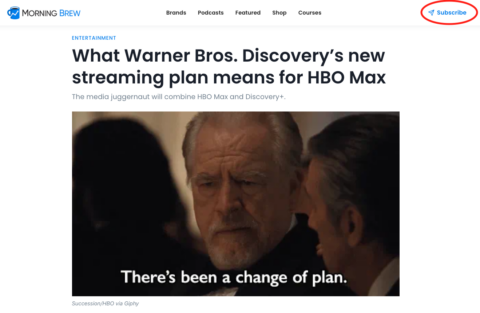

You can also sponsor other newsletters in your industry, promote your email program on social media, and more. And don’t forget to add a sign-up link within your newsletter so that if a subscriber forwards it to a friend, they can sign up as well.
Consideration
At this stage, users consider whether they want to do business with you. They might read reviews, compare your product to a competitor’s offering, and do additional research to make their decision.
If a customer signs up for your email list in the previous stage, you can use a welcome series to get them up to speed on what you have to offer. Do this by sharing customer testimonials, showcasing the features that differentiate your business from the competition, and offering incentives like a free trial for your service.
Some prospects at this stage might get close to making a purchase but back out at the last moment. But you haven’t lost them yet—a well-timed abandoned cart email nudging the recipient to finalize the purchase can get them back on track.
Purchase
A purchase or conversion is a win worth celebrating, but it’s not the end goal. This is your opportunity to turn a one-time buyer into a loyal customer and advocate.
But first, make sure the purchase process is a positive experience for the customer using the following email tactics:
- Send customers effective transactional emails with all the information they need and a way to track their purchase.
- Send a thank you email and consider including an incentive to become a repeat customer, such as a discount on their next purchase.
Retention
Once a customer has done business with you, turn your efforts to keep them engaged with your brand. You can use email in a few ways to do this:
- Send them an email with a tutorial on how to use or care for the product after a customer makes a purchase. This can also be a good opportunity to cross-sell other items or upsell a subscription (but don’t overdo it—the primary focus should be to provide value to the recipient).
- Send personalized marketing emails with product recommendations based on their previous purchases.
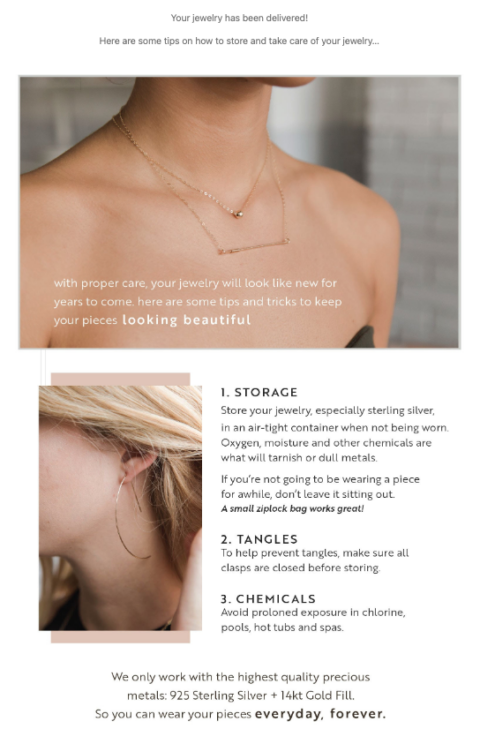

Advocacy
Customers in the advocacy stage are such big fans of your business that they willingly recommend it to others. But one of the biggest obstacles at this stage is that, most of the time, satisfied customers don’t go out of their way to leave a review. So make it easier for them to become your advocates with these email marketing tactics:
- Send customers an email requesting a review after they make a purchase. Make this as convenient as possible by including a review form right in the email or a button that takes them to the right page. Many brands also include an incentive for leaving a review, such as a promo code, points toward a loyalty program, or entrance into a giveaway.
- Send customers a referral program promotion to encourage recipients to share your brand with their friends. These typically include a benefit for both the recipient and their referred friend, such as a discount or credit.
- Send customers an invite to follow you on social media and post about your product using a particular hashtag. This can also help you gather user-generated content to use in future campaigns.
Customer journey email examples
Let’s take a look at a few examples from my inbox of brand emails that aligned to my stage in the customer journey.
A warm welcome from Brooklinen
While shopping for a robe (consideration stage), I saw Brooklinen mentioned in an article about the coziest robes of the year. So when I landed on the Brooklinen website, I signed up for its email program through a pop-up, and I received this well-timed welcome email with a discount to nudge me toward finalizing a purchase.
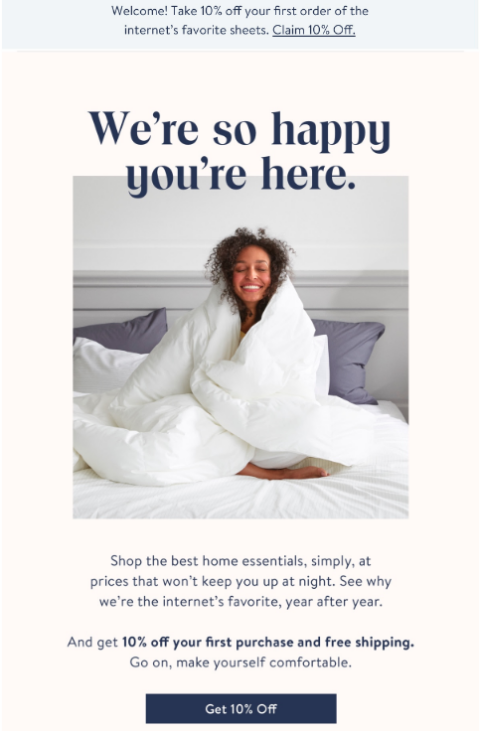

Retention incentive from Denver Botanic Gardens
I recently attended an event at the Denver Botanic Gardens (purchase stage). A few days later, the business followed up with this email that includes a discount for its annual membership. Since I’ve purchased tickets before, the Denver Botanic Gardens already know I’m interested in what it offers, which makes me a qualified lead for the next stage, retention.
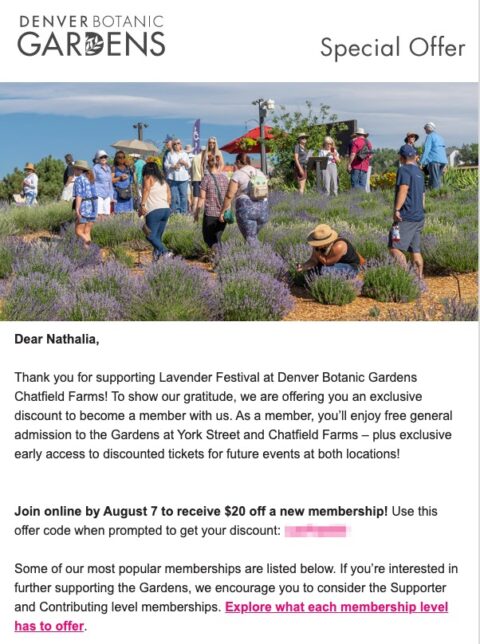

Easy advocacy from Girlfriend Collective
A few weeks after I received an order from Girlfriend Collective, the business sent me an email requesting a review (advocacy stage). The review form is embedded right in the email, removing the obstacle of me thinking, “I don’t want to go to another site to leave a review.” Additionally, it included an incentive at the bottom of the email, telling me how many rewards points I’ll receive for my feedback.
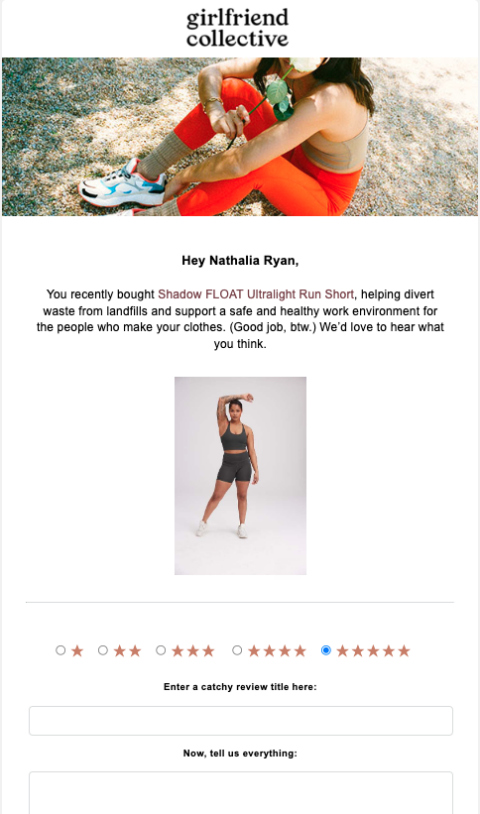

Follow the customer journey with Twilio SendGrid
When aligning your email marketing strategy with the customer journey, data and automation are your best friends. We can help with both.
Twilio Segment helps you collect the data you need to map the customer journey. And Twilio SendGrid helps you send personalized emails using time-saving automation that allows you to meet the customer wherever they are in their journey.
Sign up for free today to start sending emails for each stage of the customer journey.
Related Posts
Related Resources
Twilio Docs
From APIs to SDKs to sample apps
API reference documentation, SDKs, helper libraries, quickstarts, and tutorials for your language and platform.
Resource Center
The latest ebooks, industry reports, and webinars
Learn from customer engagement experts to improve your own communication.
Ahoy
Twilio's developer community hub
Best practices, code samples, and inspiration to build communications and digital engagement experiences.

